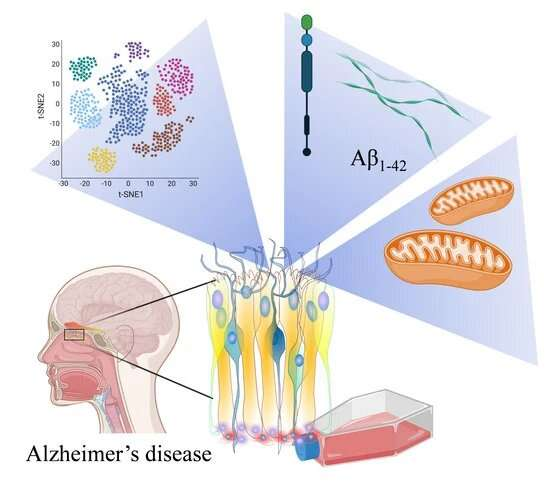Olfactory testing for Alzheimer’s is emerging as a groundbreaking method for early detection of cognitive impairment linked to neurodegenerative diseases. Research led by Mass General Brigham has demonstrated that our sense of smell could be an indicator of Alzheimer’s risk, providing insights years before traditional symptoms manifest. This innovative at-home smell test allows older adults to evaluate their olfactory function, revealing a correlation between diminished smell and cognitive decline. The findings suggest that a simple smell assessment could serve as a cognitive impairment test, enabling families and healthcare professionals to identify Alzheimer’s signs early on. Optimizing this approach may pave the way for timely interventions, enhancing our understanding of neurodegenerative conditions and improving quality of life for at-risk individuals.
The assessment of olfactory function, commonly referred to as the smell test for Alzheimer’s, is gaining attention as an invaluable tool in the realm of dementia diagnosis. This novel method allows individuals to take a home test for Alzheimer’s, empowering them to assess their risk factors for cognitive decline from the comfort of their own homes. Studies indicate that a loss of smell can be one of the subtle signs of neurodegenerative diseases like Alzheimer’s and Parkinson’s. By focusing on the olfactory system, researchers aim to develop effective methods for the early detection of cognitive impairments—even before overt symptoms are noticeable. Ultimately, enhancing our understanding of these sensory changes may lead to more precise and earlier interventions for individuals facing neurodegeneration.
Understanding the Importance of Early Detection in Alzheimer’s Disease
The early detection of Alzheimer’s disease is crucial for improving patient outcomes and developing effective treatment strategies. Identifying signs of cognitive impairment early on can significantly enhance the quality of life for individuals at risk. Researchers emphasize that symptoms of neurodegenerative diseases often begin years before noticeable memory loss occurs. Tools like olfactory testing are being studied as potential methods for spotting early signs of Alzheimer’s. By recognizing these early indications, healthcare providers can implement lifestyle changes and therapies that may slow down the progression of the disease.
In addition to memory-related symptoms, early detection focuses on other indicators of cognitive decline. Tests assessing smell, or olfaction, are emerging as valuable tools for evaluating brain health. As studies demonstrate, those with cognitive impairment perform poorly on smell tests when compared to their cognitively healthy peers. Such findings reinforce the notion that sensory changes can be critical markers of changes in brain function, thereby paving the way for inventions like at-home cognitive impairment tests that use olfactory cues.
Frequently Asked Questions
What is olfactory testing for Alzheimer’s and how does it work?
Olfactory testing for Alzheimer’s involves assessing an individual’s ability to identify and discriminate smells. In a recent study, researchers developed a home test where participants sniff odor labels to evaluate their olfactory function. This testing can help detect early signs of cognitive impairment associated with neurodegenerative diseases like Alzheimer’s.
How can olfactory tests help in early detection of Alzheimer’s?
Olfactory tests can aid in the early detection of Alzheimer’s by identifying individuals with olfactory dysfunction, which is often a precursor to cognitive decline. The research indicates that older adults with mild cognitive impairment score lower on smell tests compared to cognitively healthy individuals, suggesting that these tests can highlight early signs of Alzheimer’s.
Can olfactory tests for Alzheimer’s be performed at home?
Yes, olfactory tests for Alzheimer’s can be performed at home. The study developed a cost-effective and noninvasive test that individuals can self-administer, allowing for early detection of cognitive impairment in a familiar environment, which may increase participation in testing.
What does the research say about the relationship between olfactory function and neurodegenerative disease signs?
Research indicates that olfactory function is linked to the early signs of neurodegenerative diseases, including Alzheimer’s. A decline in smell ability can serve as an early warning sign of cognitive impairment, potentially allowing for interventions before significant memory symptoms appear.
Are there any specific signs of cognitive impairment that can be detected through smell tests for Alzheimer’s?
Yes, individuals with cognitive impairment often show a decline in their ability to identify and discriminate odors. The recent study found that those diagnosed with mild cognitive impairment had notably lower scores on the olfactory tests compared to normal cognitive adults, reinforcing the test’s potential in detecting early cognitive decline related to Alzheimer’s.
Is olfactory testing for Alzheimer’s suitable for different language speakers?
According to the study, olfactory testing for Alzheimer’s is suitable for speakers of different languages. The results showed similar performance across both English- and Spanish-speaking participants, suggesting that the test is effective regardless of language proficiency.
What are the potential next steps for olfactory testing in Alzheimer’s research?
Future studies could expand on olfactory testing for Alzheimer’s by integrating neuropsychological assessments and longitudinal tracking of participants to better predict cognitive decline. This could enhance the effectiveness of olfactory testing as a tool for early diagnosis and intervention in neurodegenerative diseases.
Can anyone take the olfactory test for Alzheimer’s or is it restricted to certain groups?
The olfactory test for Alzheimer’s is primarily aimed at older adults, particularly those who report cognitive complaints or have been diagnosed with mild cognitive impairment. However, ongoing research may expand the applicability of the test to a broader demographic focusing on early cognitive health monitoring.
How does olfactory testing compare to other cognitive impairment tests for Alzheimer’s?
Olfactory testing for Alzheimer’s presents a noninvasive and easy-to-administer alternative to traditional cognitive tests. While comprehensive cognitive assessments measure multiple aspects of brain function, olfactory tests provide a quick and focused indicator of neurodegenerative disease signs, making them a valuable tool in early detection.
| Key Points | Details |
|---|---|
| Research Background | Mass General Brigham researchers have developed an at-home olfactory test to detect risks of Alzheimer’s. |
| Olfactory Testing Purpose | To determine olfactory function as an early warning sign for neurodegenerative conditions. |
| Methodology | Participants sniff odor labels on a card to evaluate their ability to identify and remember odors. |
| Key Results | Older adults with cognitive impairment scored lower than cognitively normal individuals. |
| Future Implications | Continued research may validate olfactory testing as a predictive tool for cognitive decline. |
| Funding | Study supported by the National Institutes of Health. |
Summary
Olfactory testing for Alzheimer’s is emerging as a crucial tool for early detection of cognitive impairments. Recent research indicates that this innovative at-home test can help identify individuals at risk of Alzheimer’s years before noticeable symptoms arise. By assessing individuals’ ability to identify and remember various odors, researchers found that those with cognitive impairments scored significantly lower than their cognitively healthy counterparts. This finding underscores the potential for olfactory dysfunction to serve as an early indicator of neurodegenerative diseases. With further studies, olfactory testing could revolutionize how we approach diagnosis and treatment for Alzheimer’s, paving the way for timely interventions and improved outcomes.










